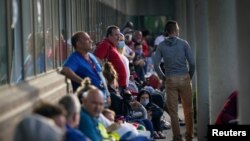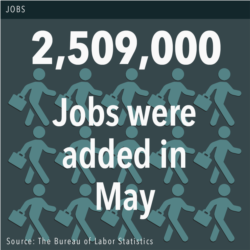Thousands of U.S. businesses are reopening after the shutdowns mandated by the coronavirus pandemic, but many are still laying off workers.
Another 1.5 million laid-off U.S. workers filed for unemployment compensation last week, the Labor Department reported Thursday. The figure was down slightly from a week ago and was the lowest weekly total in the last three-plus months, but still an unusually big figure for the world’s largest economy.
The number of workers seeking jobless benefits has now dropped steadily for 13 straight weeks, but key U.S. economic officials are predicting that the country’s full recovery from the pandemic will take a lengthy period, extending well into 2021.
In all, 45.5 million workers have filed for unemployment compensation since mid-March, more than a quarter of the U.S. labor force of 164.6 million. The number currently receiving benefits has dropped to about 20.5 million as millions of workers have now returned to their jobs.
But Jerome Powell, the chair of the Federal Reserve, the country’s central bank, told a congressional committee this week that while the U.S. economy has started to rebound from the worst of the coronavirus devastation, “levels of output and employment remain far below their pre-pandemic levels, and significant uncertainty remains about the timing and strength of the recovery.”
Overall, he said, “The shock that we received — the economy received — was the largest in living memory.”
Powell said the sharp downturn wrought by the pandemic has had a pronounced impact on certain segments of the American workforce.
“Low-income households have experienced, by far, the sharpest drop in employment, while job losses of African-Americans, Hispanics and women have been greater than that of other groups,” he said. “If not contained and reversed, the downturn could further widen gaps in economic well-being that the long expansion had made some progress in closing.”
The official U.S. jobless rate was 13.3% in May, although officials say that when a survey error was accounted for, the rate should have totaled 16.4%.
The Fed has predicted that the U.S. unemployment will fall to 9.3% by the end of this year and to 6.5% by the end of 2021, a rosier advance than some economists are forecasting.
With mass protests, including numerous chaotic clashes between demonstrators and police roiling the U.S. in the past three weeks in the wake of the May 25 death of a black man, George Floyd, while in police custody in Minneapolis, Minnesota, the plight of the unemployed has garnered far less attention.
Lawmakers in Congress and the White House have been weighing whether more government aid to workers and American families is needed to speed the economic recovery.
Treasury Secretary Steven Mnuchin told Congress a week ago, “I definitely think we are going to need another bipartisan legislation to put more money into the economy.”
House Democrats have approved about $3 trillion in new spending, which would provide more aid for states and cities, among other things. But Senate Republicans and the White House have rejected the plan and are considering other options to boost the economy.
One idea is to send cash to workers who return to their jobs, perhaps $1,200, to remove them from the millions of people collecting unemployment compensation.
Powell said the Fed is “committed to using our full range of tools to support the economy in this challenging time,” but that Congress can “provide direct help to people, businesses and communities. This direct support can make a critical difference not just in helping families and businesses in a time of need, but also in limiting long-lasting damage to our economy.”
COVID death toll
The U.S. death toll from the virus has now topped 117,000, by far the most in the world, and health experts predict tens of thousands more will die in the coming months. But President Donald Trump, facing a November reelection contest against former Vice President Joe Biden, said Wednesday the coronavirus is “dying out” and is predicting the country will have a robust economic recovery.
But the number of coronavirus cases reached a peak in some states in recent days and some restaurants that had reopened have now closed again after their workers tested positive for the coronavirus.
The coronavirus has had a major effect on U.S. commerce, with more than two dozen companies filing for bankruptcy protection in May.
Yelp, which publishes crowd-sourced reviews about businesses, says that more than 143,000 U.S. businesses have closed since the outbreak of the coronavirus pandemic and that about 50,000 of those businesses are not expecting to reopen.
The government says the national economy dropped 4.8% in the first quarter, but that was before the full impact of the pandemic became apparent for the April-to-June quarter.
Numerous states still require social distancing of at least two meters between people in stores and some major retail outlets are requiring their employees and customers to wear face masks. Some governors are limiting restaurants to half capacity or only allowing out-door eating with appropriate social distancing.
But in other states, the restrictions have been significantly lifted and crowds have quickly emerged to resume life, shopping or enjoying a day at Atlantic and Pacific beaches, often ignoring the admonitions of health experts to maintain a safe distance from others or to wear a face mask. Trump is planning his first large-scale political rally Saturday night in Tulsa, Oklahoma, with more than 19,000 supporters expected to crowd into an arena.
U.S. workers filing for jobless benefits normally are paid slightly less than half their normal salaries. But these payments are currently being augmented during the pandemic with $600-a-week supplements from the federal government for four months, but these payments are ending at the end of July.
The peak of the unemployment benefit claims likely came in late March with 6.9 million workers filing for the jobless compensation in one seven-day period.
But the millions of claims have still been unparalleled over decades of U.S. economic history, reaching back to the Great Depression in the 1930s. The number of claims has far exceeded those made during the Great Recession in 2008-2009.












